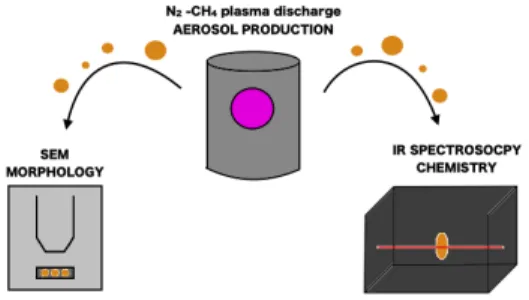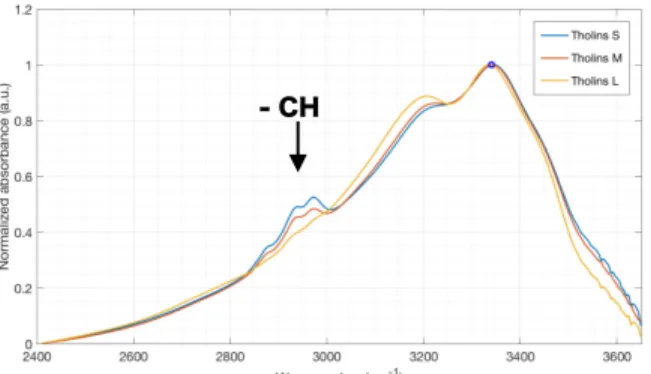HAL Id: insu-02292396
https://hal-insu.archives-ouvertes.fr/insu-02292396
Submitted on 19 Sep 2019
HAL is a multi-disciplinary open access
archive for the deposit and dissemination of
sci-entific research documents, whether they are
pub-lished or not. The documents may come from
teaching and research institutions in France or
abroad, or from public or private research centers.
L’archive ouverte pluridisciplinaire HAL, est
destinée au dépôt et à la diffusion de documents
scientifiques de niveau recherche, publiés ou non,
émanant des établissements d’enseignement et de
recherche français ou étrangers, des laboratoires
publics ou privés.
Analogues of Titan’s aerosols: the different steps of
formation in a N2-CH4 plasma
Zoé Perrin, Audrey Chatain, Nathalie Ruscassier, Ludovic Vettier
To cite this version:
Zoé Perrin, Audrey Chatain, Nathalie Ruscassier, Ludovic Vettier. Analogues of Titan’s aerosols: the
different steps of formation in a N2-CH4 plasma. EPSC-DPS Joint Meeting 2019, Sep 2019, Geneva,
Switzerland. pp.EPSC-DPS2019-2035. �insu-02292396�
Analogues of Titan’s aerosols: the different steps of
formation in a N
2
-CH
4
plasma
Zoé Perrin (1), Audrey Chatain (1,2), Nathalie Ruscassier (3) and Ludovic Vettier (1)
(1) LATMOS/IPSL, UVSQ Université Paris-Saclay, Sorbonne Université, CNRS, Guyancourt, France (2) LPP, Ecole polytechnique, Sorbonne Université, université Paris-sud, CNRS, Palaiseau, France (3) LGPM, Centrale-Supélec, Gif-sur-Yvette, France
audrey.chatain@latmos.ipsl.fr
Abstract
Observations by the Cassini mission show the presence of aerosols in Titan's atmosphere. According to models, these aerosols should reside there during several years. A plasma reactor is used to simulate the production of aerosols in the upper atmosphere of Titan. Five productions of aerosols were carried out with different residence times in the plasma, corresponding to different stages of evolution. These analogues were then analyzed by electron microscopy and infrared spectroscopy. Our results show that aerosols undergo morphological evolution in time. They grow and start forming aggregates at a certain stage. In addition, we also observed evolutions of the chemical functions present in the aerosols of different formation times.
1. Introduction
Titan, Saturn's largest satellite, the only satellite in the Solar System with a dense atmosphere. This atmosphere is composed of 95-98.4% nitrogen and 1.6-5% methane depending on the altitude. Observations by DISR and UVIS instruments onboard Cassini/Huygens revealed the presence of complex organic particles, in suspension in the atmosphere, from the thermosphere to the troposphere.
Aerosol production begins in the ionosphere at an altitude of 1,200 km[1], where photons and energetic particles are able to ionize dinitrogen and methane, generating a complex ion organic chemistry. Thereafter, the organic grains formed reside several years in Titan's atmosphere[2]. We suspect that these aerosols evolve during their stay in the atmosphere [3]. Laboratory experiments were conducted using a plasma reactor simulating Titan's ionosphere, thus reproducing the formation of organic aerosols, called tholins. In this work we study the evolution of aerosols during their stay in the plasma. Five tholins productions were carried out with different residence times in the plasma.
2. Aerosol production
Analogues of Titan aerosols are formed using the experiment PAMPRE [4]. PAMPRE is a reaction chamber, where a cold radiofrequency plasma capacitively coupled is ignited at low pressure (~0.9 mbar). A gas mixture of 95% N2 and 5% CH4 is
introduced into the reactor. Subsequently, a 30W discharge is generated between two electrodes, which ionizes the N2 and CH4 present.
In this plasma, organic particles form similarly as in Titan's ionosphere. These particles levitate in the plasma until they reach a limit size and sediment. Five tholins productions were carried out by with different residence times of tholins in the plasma, as in [6]. For this purpose, the plasma can be operated in continuous or in pulsed mode. Under pulsed conditions, the duration of the plasma is limited in order to stop the growth of solid particles before they reach the size of sedimentation. The discharge time is a few seconds and the time interval between two discharges is one minute, which allows the gas to be renewed and the tholins to sediment. On the other side, to increase the residence time we decreased the gas flow rate in continuous mode.
These different aerosols were then analyzed by electron microscopy to determine their morphology and size distribution. Evolution of their chemical functions were observed by IR spectroscopy (Fig.1).
Figure 1 : Experimental method EPSC Abstracts
Vol. 13, EPSC-DPS2019-2035, 2019 EPSC-DPS Joint Meeting 2019
c
3. Morphology analysis by scanning
electron microscopy
Samples formed were observed by Scanning Electron Microscopy (SEM). A Field Emission Gun SEM (Leo 1530) was used to reach a magnification of x 60 000, necessary to detect the smallest grains and analyse their surface texture. We also studied the size distribution of grains as function of their formation conditions. For each sample, grains are detected and counted on ~10 pictures thanks to a semi-automatic program using the Hough transform.
Figure 2 : SEM pictures of different samples. From left to right : tholins with shorter residence time. At first glance, isolated tholins have a spherical shape (Fig. 2). However, tholins with a longer residence time have a larger size : ~130 nm for those formed in 30s, compared to ~1.5 µm for those formed in several minutes. In addition, we observed more agglomerates for tholins with longer formation times in the plasma. To conclude, the longer tholins stay in the plasma, the more they grow and agglomerate, as predicted by Lavvas [3].
4. Chemical analysis by infrared
spectroscopy
A Fourier transform infrared spectrometer is used for this analysis. We made pellets composed of ~ 99.6% KBr and ~ 0.4% tholins. These pellets are placed in a vacuum chamber to avoid the absorption of CO2 and
water from the ambient air. The chamber is also heated to evaporate the water absorbed on the sample, mainly due to KBr which is highly hydrophilic. Thereafter, the absorbance measurement is made with the FTIR with a resolution of 4 cm-1.
Several spectra are measured on the same pellet at different positions for reproducibility. A pure KBr pellet is used as reference.
Figure 3 : Normalized IR spectra showing the evolution of CH bands for different residence times
of tholins
IR absorption band give indications on the presence of chemical functions [5]. The absorption bands vary with the residence time of tholins in the plasma. In particular, the -CH bands (Fig. 3) decrease for tholins with longer residence times. On the contrary, the band of isonitriles (2140 cm-1) increases the longer
the tholins stay in the plasma.
5. Summary and Conclusions
To conclude, morphological and chemical evolutions were observed as a function of the residence time of the particles in the plasma. Indeed, during the SEM analysis, it was observed that the longer the residence time of tholins in plasma, the more tholins grow and form aggregates. With regard to the IR analysis, it was noted that isonitriles increase and CH bonds disappear, the longer the grains reside in the plasma. Our experimental results are coherent with numerical models based on Cassini observations : A similar morphological evolution of the grains is expected in Titan’s atmosphere. We showed that a chemical evolution of the grains could also happen.
References
[1] Waite Jr. J.H. et al., Science 316.5826 (2007). [2] Lavvas P. et al., The Astrophysical Journal (2011). [3] Lavvas P. et al., National Academy of Sciences (2013). [4] Szopa C. et al., Planetary and Space Science 54 (2006). [5] Gautier T. et al., Icarus, 221, 320-327 (2012).
[6] Hadamcik E. et al, Planetary and Space Science (2009)
- CH

